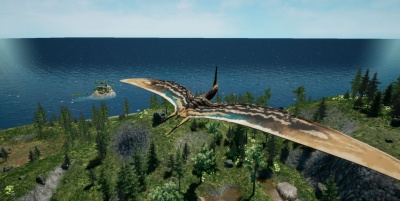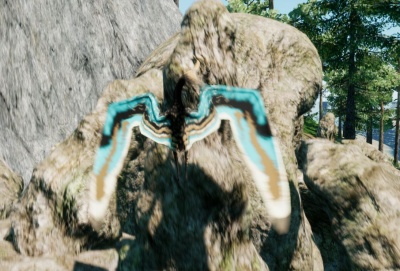Difference between revisions of "Flying Creatures"
Bermudabeast (talk | contribs) |
Bermudabeast (talk | contribs) |
||
| Line 1: | Line 1: | ||
| − | [[File: | + | [[File:Pteranodon_Flight2.JPG|right|thumb|400px|border|Mosasaurus]] |
Beasts of Bermuda contains, currently, only one creature capable of flight. This is the [[Pteranodon]]. | Beasts of Bermuda contains, currently, only one creature capable of flight. This is the [[Pteranodon]]. | ||
Revision as of 17:57, 8 August 2017
Beasts of Bermuda contains, currently, only one creature capable of flight. This is the Pteranodon.
Flying creatures are typically highly adept flyers, but perform poorly when maneuvering on land.
Flying creatures have very poor weather resistance, and must be particularly wary of stormy weather.
Contents
Takeoff
In order to take off, a player must be sprinting, jumping, and moving upwards. If all three of these conditions are met, the player will take off. If the player is taking off in a location surrounded by obstructions such as rocks or trees, it is highly likely they will crash into these objects and end up back on the ground again. Takeoff takes 35 stamina, so it cannot be spammed too frequently.
Flight
The Pteranodon's flight was inspired greatly by the Primal Carnage Pteranodon due to its control and capability in a combat scenario.
As a player maneuvers and takes turns, the sharpness of these turns will increase to the point where they can twirl, or nearly hover in place. This mechanic was greatly inspired by the PC Pteranodon's capabilities to do just this. It allows a player to hover, or wait for the opportune strike moment.
As a player continues to dive, they will accumulate what is referred to as dive boost. Dive boost is a speed boost that becomes progressively greater the longer the player has been diving. This allows flyers to build up to significant speeds if they wish.
Speed dictates the rate at which a flyer can adjust their pitch angle. The faster a player is going, the more difficult it will be for them to adjust their pitch angle.
Speed dictates how much damage the Pteranodon will do with itspeck attack. It will do a lot more damage if the player has gained significant amounts of dive boost.
The maximum angle at which a player can climb into the sky while flying is dictated by speed. The faster a player is going, the more vertical their ascent can be. A flyer who has gained a significant amount of dive boost will be capable of near vertical ascent, whereas one who is merely gliding will only be capable of meager ascent angles.
Sprinting while in the sky increases speed, allowing a greater ascent angle. The greater the ascent angle while going upwards, the more rapidly a flyer will consume stamina. Flyers use and regain stamina significantly faster than other animals.
Crashing
Flying creatures are often fragile. They take injury damage when hit by any source of damage, regardless of whether or not it hits the wing, head, legs, or torso. Hitting obstructions such as walls, cliffs, trees, and rocks while airborne will result in a crash, in which the player loses complete control of their flyer as it falls out of the sky. A crash will result in significant injury damage. The faster the player was going upon impact, the more severe the injury and damage accrued during the impact. The player will regain control of their flyer once it hits the ground and comes to rest. It is very easy to die by sufficiently hard impacts.
Landing
In order to land safely, the player has two options. The first method of landing is simple and intuitive. A player must simply come into contact with a suitable surface. If the speed in which they are flying is slow enough, they will land safely. If they are going to fast or if the place in which they are trying to land is unsuitable for a landing, they will crash instead, taking injury damage or potentially dying. Unsuitable locations are any location in which the slope of the terrain or object is too steep. Trying to land on a nearly vertical cliff face will result in a crash, for example.
The second way to land a flyer is to get close to the ground or to any suitable surface and hold the use keybind. This will cause the flyer to force-land itself any time it detects a suitable surface. If it cannot find a suitable surface, the player will not land, but they also will not crash. This allows players to attempt to land on particularly precarious surfaces such as the tops of rocks, pinnacles, or trees, without suffering flyer crashes due to the game being finicky on landing in these difficult areas.

